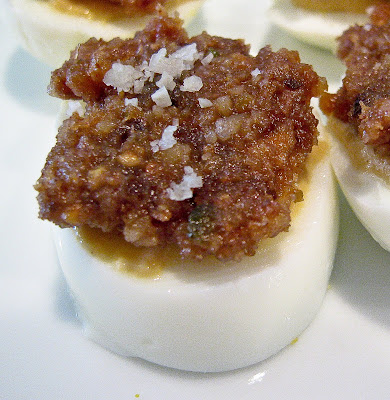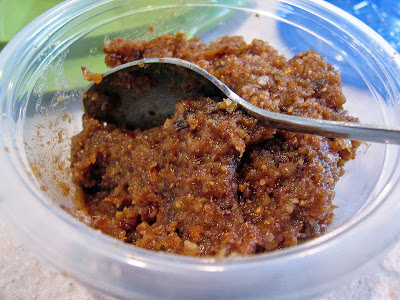
I am not a particularly religious person; nor do I stand on much ceremony. When religion and/or ceremony has been a part of my life, my 2 primary concerns have been that guests be made to feel welcome and that nothing be too long. I come from a family that is more comfortable telling a snarky joke than wearing heartfelt emotion on our sleeves.
So when I was invited to a Passover Seder at a friend’s home, I had no idea what to expect. She is not Jewish, but her family is mixed faith, and they do maintain–to this outsider’s eyes–a somewhat traditional Seder. (Because I am not Jewish I will not presume to explain the Seder but the Wikipedia link seems fairly accurate for what I experienced.) Their Seder was marked by solemnity and levity both, and I felt both welcomed and a part of the ceremony. It was a delightful tradition, showcasing brilliantly the ways in which food, culture and family come together.

When I left, my friend’s aunt gave me some leftover haroset (also spelled charoset) to take home with me. Haroset is a fruit and nut paste, frequently made with wine, that is quite sweet and is symbolic of the mortar with which the Jews sealed bricks together when they were slaves in Ancient Egypt. During the ceremony, at one point the haroset is deliberately eaten with matzoh, horseradish, and a hard boiled egg (some of these ingredients may differ from home to home and country to country).

It was a shockingly delicious combination. So when I got home, I used the leftover haroset to make little hardboiled egg dishes for Alex and myself for lunch, comprised of sliced hard boiled eggs, dijon mustard (I wish I had had Dijon with horseradish), the haroset, and coarse grey sea salt. I hate hard boiling eggs–ok I hate peeling hard boiled eggs–so you know I really liked this combination, both at my friend’s home and the version I made for myself the next day, since I immediately boiled myself some eggs for it. I have several more eggs waiting in the fridge for tomorrow as well-and for once I am looking forward to lunch.
- 2 cups walnuts
- 1 cup blanched slivered almonds
- ½ cup shelled pistachios
- 10 large figs, preferably Calymiria
- 20 dried apricots
- 10 (14-15 regular sized) large pitted prunes
- 25 pitted dates
- ½ - 2 cups white grape juice
- ½ cup Pesach sweet wine, to taste (you may need more) (this is sweet red wine for Passover, I believe)
- ½ - 2 t cinnamon, to taste
- ¼ - ⅜ t salt, to taste
- If desired, freeze the dried fruit for 15-20 minutes to reduce stickiness.Using a food processor and working in small batches, process the nuts until fluffy and beginning to make a paste.Add each batch to a large bowl.Then process a large handful of dried fruit at a time, using a little white grape juice each time.Pulsing the food processor helps prevent splatters.Process the fruit until it is fairly finely grated.Add to the large bowl.
- Add the minimum amount of Pesach wine, cinnamon and salt and stir thoroughly.Continue to stir, adding more wine and/or grape juice, and cinnamon, tasting until you like it.The amount of liquid depends on the moisture in the fruit.This mixture gets very stiff so extra liquid helps soften it so people can serve themselves at the table.Chill.
- Remove from fridge four hours before serving to allow Haroset to come to room temperature.Serve spread on matzoh crackers with beet horseradish (optional).
- If desired, pack some in small, disposable plastic containers for guests to take home if they wish.

Wow, what a beautiful combination. It sounds and looks delicious.
I've never eaten haroset at the same time as a hard boiled egg. Have to try that. Thanks for the suggestion!
this is soo incredibly unique and appealing to my tastes! number one, haroset sounds delightful by itself, and number two, this combination would be like a party in the mouth. so nice, laura–thanks!
I'm with Holly – never heard of doing that! We do eat eggs in the first course of the meal, though. Sounds like a yummy combo!
Also, I highly recommend Sephardic recipes for charoset (from Middle Eastern, North African and Western European countries) over the Ashkenazic kind I grew up with. Ours is fine, but the Sephardic ones use different fruits and a bit more kicky spices too. Mmmm.
I agree, I've never seen that combination at Seder. Haroset and horseradish on matzo during the ceremonial portion followed by hardboiled eggs served with saltwater as one of the courses during the actual meal. Now I'm going to have to ask around and see if anyone else has heard of this combo. Very interesting.
Amy: Allison made a point of telling me (later, after I typed the post) that they also started with Ashkenzic haroset recipes but also much preferred the Sephardic. They were also trying to decrease the amount of Passover wine used bc they found it really sweet.
As to the combo, at one point I think maybe the haroset was meant to be smeared on the matzo, but in their family they preferred to make what the guys, her cousins (clearly something invented as children) called haroset egg sandwiches. It was hard at that point for me to tell what was traditional and what was a family tradition. Either way it was oh my yummy.
I've been to one seder in my lifetime and thought all of the traditions were so interesting!
This haroset looks delicious. Such an interesting combo with this eggs.
Great combination! I love it with all the walnuts and dates! Yum!!!
Not that it will matter to you, but just as a point of interest the only Passover wine available used to be Manischewitz, which is extremely sweet Concord grape stuff. However, in the last decade or so there has been a ton of growth in this area, and there are now a reasonably wide variety of kosher for Passover wines that taste pretty good. We are much happier drinkers now! Not sure how easy it is to find them where you guys are vs. NY, of course.
Happily, the holiday ended at sundown and we ate pasta for dinner tonight!!! Looking forward to bread at breakfast… yay.
Laura, So glad that you got a chance to go to a seder. (I realize that this post is a few years old and maybe you’ve gotten to a few more by the time I write this.) Charoset is one of the best parts of the seder ceremony and meal as far as I’m concerned, and your dish is a wonderful way to keep the seder going. If you’re interested in more information about what seders are all about, I wrote a post on it based on conversations with Yvonne Maffei of My Halal Kitchen. http://www.motherwouldknow.com/journal/what-to-expect-at-your-first-seder.html
This looks delicious! What an interesting combination!
I have never heard of haroset or it over hard-boiled eggs. That being said, it sounds really good! I love trying new things and this seems perfect!
this sounds really good actually and I’ve never heard of it but then I dont know anyone that celebrates Passover, so that probably explains it right there 🙂
Laura,
I’m quite game to try this–the haroset I’ve had has been more chunky–and I made a muffin with it 😉 but this looks awesome.
Thanks!
Sounds like a great combo of flavors! I love the sound of the haroset, and your friends’ traditional meal sounds like a great experience!